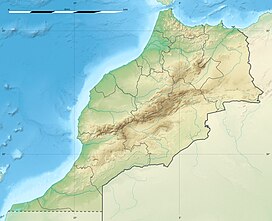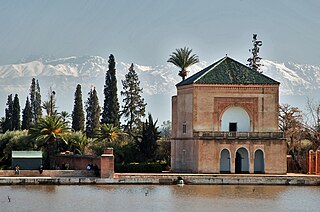
Marrakesh or Marrakech is the fourth-largest city in Morocco. It is one of the four imperial cities of Morocco and is the capital of the Marrakesh–Safi region. The city lies west of the foothills of the Atlas Mountains.

The Atlas Mountains are a mountain range in the Maghreb in North Africa. It separates the Sahara Desert from the Mediterranean Sea and the Atlantic Ocean; the name "Atlantic" is derived from the mountain range, which stretches around 2,500 km (1,600 mi) through Morocco, Algeria and Tunisia. The range's highest peak is Toubkal, which is in central Morocco, with an elevation of 4,167 metres (13,671 ft). The Atlas Mountains are primarily inhabited by Berber populations.
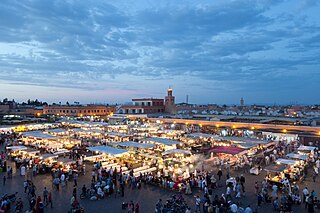
Jemaa el-Fnaa, also Jemaa el-Fna, Djema el-Fna or Djemaa el-Fnaa, is a square and market place in Marrakesh's medina quarter. It remains the main square of Marrakesh, used by locals and tourists.

The High Atlas, also called the Grand Atlas, is a mountain range in central Morocco, North Africa, the highest part of the Atlas Mountains.

The culture of Morocco is a blend of Arab, Berber, Andalusi cultures, with Mediterranean, Hebraic and African influences. It represents and is shaped by a convergence of influences throughout history. This sphere may include, among others, the fields of personal or collective behaviors, language, customs, knowledge, beliefs, arts, legislation, gastronomy, music, poetry, architecture, etc. While Morocco started to be stably predominantly Sunni Muslim starting from 9th–10th century AD, during the Almoravid period, a very significant Andalusi culture was imported, contributing to the shaping of Moroccan culture. Another major influx of Andalusi culture was brought by Andalusis with them following their expulsion from Al-Andalus to North Africa after the Reconquista. In antiquity, starting from the second century A.D and up to the seventh, a rural Donatist Christianity was present, along an urban still-in-the-making Roman Catholicism. All of the cultural super strata tend to rely on a multi-millennial aboriginal Berber substratum still present and dating back to prehistoric times.

A riad or riyad is a type of garden courtyard historically associated with house and palace architecture in the Maghreb and al-Andalus. Its classic form is a rectangular garden divided into four quadrants by two paved paths intersecting in the center, where a fountain is typically situated. The planted areas are usually sunken below the level of the paths. Its origin is generally attributed to traditional Persian gardens whose influence spread during the Islamic period. The term "riad" is nowadays often used in Morocco to refer to a hotel or guesthouse-style accommodation with shared common areas and private rooms, often within a restored traditional mansion.

The Museum of Marrakech is a historic palace and museum located in the old center of Marrakesh, Morocco. In addition to its notable architecture, the museum's collection showcases various historic art objects and contemporary art from Morocco.

Aït Benhaddou is a historic ighrem or ksar along the former caravan route between the Sahara and Marrakesh in Morocco. It is considered a great example of Moroccan earthen clay architecture and has been a UNESCO World Heritage Site since 1987.
Nass Marrakesh is a Gnawa music group formed in 1991. They introduced instruments foreign to Gnawa music such as the djembe, tam-tam, mandolin, tabla and Afro-Cuban percussion.

Khenifra is a city in northern central Morocco, surrounded by the Atlas Mountains and located on the Oum Er-Rbia River. National Highway 8 also goes through the town. The population, as of a 2019 census, was 228,567.
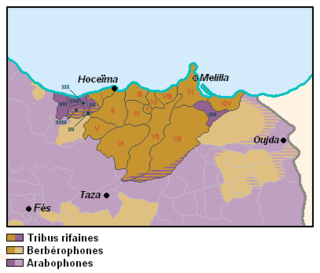
Gzenaya or Igzenayen is the name of a Riffian tribe of the Rif region in the north-eastern part of Morocco. Towns such as Aknoul, Ajdir Gzenaya and Ain Hamra belong to this tribe. Many Igzenayen can also be found in cities such as Tangier, Taza and Meknes.
Jil Jilala is a Moroccan musical group which rose to prominence in the 1970s among the movement created by Nass El Ghiwane and Lem Chaheb. Jil Jilala was founded in Marrakech in 1972 by performing arts students Mohamed Derhem, Moulay Tahar Asbahani, Sakina Safadi, Mahmoud Essaadi, Hamid Zoughi and Moulay Abdelaziz Tahiri. In 1974, they released their first record Lyam Tnadi on the Atlassiphone label. The songs "Leklam Lemrassaa," "Baba Maktoubi," "Ha L'ar a Bouya," "ah ya Jilala" and "Chamaa" quickly achieved the status of popular 'classics.'
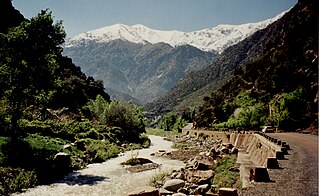
Ourika River is a river in Morocco, at 31.4°N 7.783333°W. It rises in the High Atlas and flows through the Ourika Valley, 30 km from Marrakech.
Aghmat was an important commercial medieval Berber town in Morocco. It is today an archaeological site known as "Joumâa Aghmat".
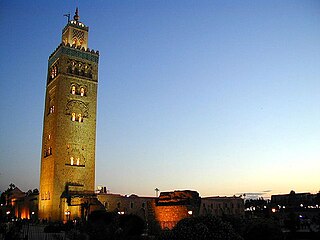
This article describes notable landmarks, architecture, and museums in the city of Marrakesh, Morocco.

Ait Ourir is a town and municipality in Al Haouz Province, Marrakesh-Safi, Morocco. At the time of the 2004 census, the commune had a total population of 20,005 people living in 3767 households. The town lies on the northern bank of the Ourika River, 29.8 kilometres (18.5 mi) by road to the northwest of Tighedouine and 33.3 kilometres (20.7 mi) east of the city centre of Marrakesh.
Acrodenta is an extinct genus of Late Permian captorhinid known from Marrakech-Tensift-Al Haouz of Morocco.
Sidi Abdelmoumen is a town and rural commune in Chichaoua Province of the Marrakech-Safi region of Morocco. At the time of the 2014 census, the commune had a total population of 9007 people living in 1908 households, it content many douars like Tarselt, Ait Smail, Tadnest.

The Zawiya of Sidi Abd el-Aziz is an Islamic religious complex (zawiya) in Marrakesh, Morocco. It is centered around the tomb of the Muslim scholar and Sufi saint Sidi Abu Faris Abd al-Aziz Abd al-Haq at-Tabba', who died in Marrakesh in 1508. Sidi Abd el-Aziz is considered one of the Seven Saints of Marrakesh, and his tomb was a prominent stop for pilgrims to Marrakesh. The zawiya is located on Rue Mouassine at its intersection with Rue Amesfah.
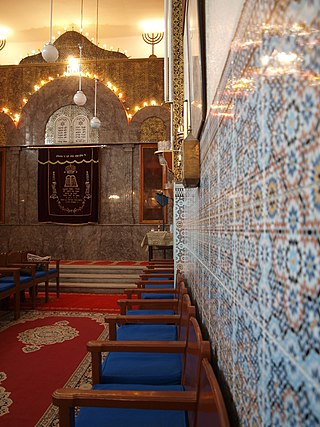
The Slat al-Azama Synagogue or Lazama Synagogue is a Jewish congregation and synagogue, located in Marrakesh, Marrakesh-Safi, Morocco. It is located in the historic Mellah of the old city.

